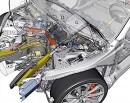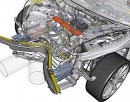When it comes to electricity versus internal combustion, the former has an unparalleled advantage in terms of responsiveness and torque. There’s also the low cost of ownership and silence of an electric powertrain, which makes the Tesla Model 3 an interesting alternative to the BMW 3 Series or even the M3 if you’re willing to spend top dollar on the Performance.
Customers who went for 310 miles of range, all-wheel drive, and 3.3 seconds from 0 to 60 have another reason to celebrate their purchase, as Tesla announced the introduction of Track Mode for the $64,000 electric sedan. According to the Palo Alto-based automaker, this feature “is designed specifically for use on closed autocross circuits and racetracks.”
More to the point, Tesla’s engineers wanted to “use that same motor power and torque to make cornering on the track feel just as natural as forward acceleration.” The most important aspect of Track Mode is torque control, which regulates traction on each wheel to make technical driving easier than ever before.
Stability control has been replaced by what Tesla calls Vehicle Dynamics Controller, a software that acts both as stability control and as a performance enhancer on the racing circuit. Motor Torque for Rotation is another highlight, commanding up to 100 percent of the torque to the front or rear axle.
Heavier regenerative braking helps with keeping the battery juiced up, but also gives the Vehicle Dynamics Controller more authority over creating or arresting rotation when the driver's right foot lifts off the accelerator pedal. In order to keep the battery and motors as cool as possible, the cooling system can overclock the AC compressor in preparation for track driving and in between sessions.
Last, but certainly not least, Tesla promises enhanced cornering power thanks to open differentials that send an equal amount of torque from the motors to both the left and right wheels of the Model 3 Performance. In order to prevent excess slip on the inside tire during cornering, the car is programmed to apply braking force and motor torque to produce “a net increase in tractive force.”
As with most other technological aspects of the Model 3, Tesla has taken to “improve and enhance Track Mode over time with future over-the-air updates.”
More to the point, Tesla’s engineers wanted to “use that same motor power and torque to make cornering on the track feel just as natural as forward acceleration.” The most important aspect of Track Mode is torque control, which regulates traction on each wheel to make technical driving easier than ever before.
Stability control has been replaced by what Tesla calls Vehicle Dynamics Controller, a software that acts both as stability control and as a performance enhancer on the racing circuit. Motor Torque for Rotation is another highlight, commanding up to 100 percent of the torque to the front or rear axle.
Heavier regenerative braking helps with keeping the battery juiced up, but also gives the Vehicle Dynamics Controller more authority over creating or arresting rotation when the driver's right foot lifts off the accelerator pedal. In order to keep the battery and motors as cool as possible, the cooling system can overclock the AC compressor in preparation for track driving and in between sessions.
Last, but certainly not least, Tesla promises enhanced cornering power thanks to open differentials that send an equal amount of torque from the motors to both the left and right wheels of the Model 3 Performance. In order to prevent excess slip on the inside tire during cornering, the car is programmed to apply braking force and motor torque to produce “a net increase in tractive force.”
As with most other technological aspects of the Model 3, Tesla has taken to “improve and enhance Track Mode over time with future over-the-air updates.”









































